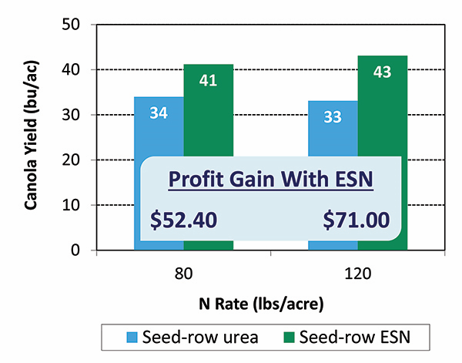Smart canola nitrogen management

Proper nitrogen nutrition of canola is critical to high yields and overall plant health, including the photosynthetic factory that converts solar energy to proteins, starches and oil. If too much nitrogen is applied early in the growing season, it can cause excessive vegetative growth and lodging. Controlling the rate of nitrogen supply to canola by using ESN can help increase nitrogen use efficiency by protecting the nitrogen from loss until the period of rapid crop uptake.
The following three canola trials demonstrate ESN’s superior performance on canola in a variety of application rates and weather conditions.
ESN Produces Flexibility and Profits for Seed-Row Nitrogen Application

Location: Melfort, Saskatchewan
Researcher: Agriculture and Agri-Food Canada
Results:
A three-year study examined the performance of ESN and urea in seed-row nitrogen application. The study demonstrated ESN’s high degree of safety for seed-placed applications. The high degree of safety makes ESN the perfect N source for one-pass, direct-seed operations eliminating additional application and equipment costs. Yield increases observed with ESN translate to significant increases in canola profitability over that observed with urea.
-ESN and urea were placed in the seed-row at planting at rates of 80 and 120 lbs N/acre
-At 80 lb N/acre, ESN produced 7 bu/acre more yield and $52.40/ acre more profit.
-At 120 lb N/acre, ESN produced 10 bu/acre yield and $71.00/acre more profit.
ESN Is The Smart Nitrogen To Maximize Canola Production On The Canadian Prairies

Location: Alberta, Manitoba and Saskatchewan
Researcher: Agriculture and Agri-Food Canada scientists in collaboration with provincial government researchers at sites across Manitoba, Saskatchewan and Alberta
Results:
Research trials ran at various locations between 2004 and 2010 to assess the use of ESN compared to urea. Comparisons were made at the same rate, timing and placement for each N product. Results indicated that yields were maximized when ESN was the applied N source, and that there were trends at some sites in some years for greater oil content (data not shown). Additionally, measurements indicated no differences in maturity or green seed (chlorophyll content) number.
On average, across all sites and years (varying environments, soil types/textures and growing season weather, etc.), canola yields were increased between 8 and 10% when ESN was the N source applied. ESN provided available and protected N season long, for full canola development.
ESN Demonstrates Superior Performance Under Dry Conditions

Location: Alberta
Researcher: Mackenzie Applied Research Association (MARA)
Results:
A 2015 canola study demonstrates ESN’s superior performance under dry conditions. The study focused on yield and oil content comparisons of various enhanced efficiency fertilizers. ESN took the lead in both higher yields and oil content. Treatments were band applied unless otherwise noted.
The smarter nitrogen for canola
ESN is the only controlled-release nitrogen designed for agriculture that delivers a significant return on investment through increased nitrogen efficiency. Interested in trying ESN for your canola crop? Read our general use recommendations or contact your local rep for recommendations specific to your farm’s conditions.


